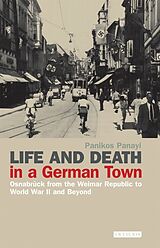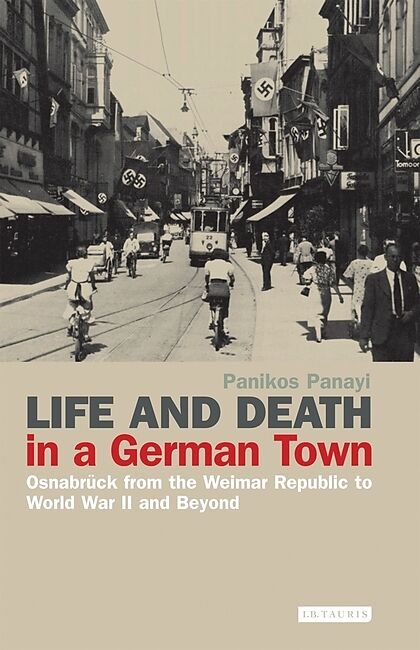Life and Death in a German Town
Einband:
Fester Einband
EAN:
9781845113483
Untertitel:
Osnabrück from the Weimar Republic to World War II and Beyond
Genre:
Geschichte
Autor:
Panikos Panayi
Herausgeber:
Bloomsbury Academic
Anzahl Seiten:
384
Erscheinungsdatum:
28.03.2007
ISBN:
978-1-84511-348-3
Informationen zum Autor Panikos Panayi is Professor of European History at the School of Historical and International Studies! De Montfort University! Leicester Klappentext The period between 1929 and 1949 is arguably the most traumatic and destructive in the history of Germany. Using vital primary sources! archival material and revealing interviews! Panikos Panayi presents an extraordinary analysis of the experiences of! and relationships between! native ethnic Germans! German refugees from Eastern Europe! German Jews! Romanies and foreigners in the German town of Osnabruck during these turbulent years. Written from the perspective of everyday life! this is the first major study of the dramatic changes that took place from the end of the Weimar Republic and the period of Hitler's ascendancy! to the Second World War! the defeat of the Nazis and the beginning of the Federal Republic! all as seen through the experiences of the different socio-ethnic groups. The story of Osnabruck is the story of the tragedy that engulfed Germany in the first half of the twentieth century and! in doing so! defined a generation. Using primary sources, archival material and interviews, this work presents an analysis of the individual experiences of, and relationships between, various groups living in the German town of Osnabruck. It focuses on Alltagsgeschichte to understand the realities for people living in one German location in a time of great change and upheaval. Zusammenfassung The period between 1929 and 1949 represents one of the most traumatic and destructive in the history of Germany. Economic crisis, Nazism, war, destruction and post-war dislocation dominated the lives of all Germans and those living in Germany. While all ethnic groups faced great hardship during these years, there were stark differences between the experience of native ethnic Germans, German refugees from Eastern Europe, German Jews, Romanies and foreigners. Using vital primary sources, archival material and insightful interviews, Panikos Panayi presents an extraordinary analysis of the individual experiences of, and relationships between, all these groups living in the German town of Osnabruck. He focuses on Alltagsgeschichte (the history of everyday life) to understand the realities for people living in one German location in a time of great change and upheaval. By concentrating on the wide span of 20 years of German experience he brings original breadth to an area of study, more commonly associated with the narrower focus of 1933-45.Despite the centrality of race in Nazi ideology, this is the first major study to look at the lives of all of the differing ethnic groups in Germany during this period. Panayi reveals the fluidity of the borderline between victims and perpetrators, how the use of forced labour dramatically changed the ethnic composition of the town and the impact of the arrival of German refugees from Eastern Europe at the end of World Wa II. Panayi's revealing analysis of the continuity and discontinuity in the everyday lives of Osnabruckers between 1929 and 1949, and the inter-ethnic relations during this period, is an essential reference tool for anyone wanting to understand the now time realities of living in Nazi Germany....
Vorwort
Using primary sources, archival material and interviews, this work presents an analysis of the individual experiences of, and relationships between, various groups living in the German town of Osnabruck. It focuses on Alltagsgeschichte to understand the realities for people living in one German location in a time of great change and upheaval.
Autorentext
Panikos Panayi is Professor of European History at the School of Historical and International Studies, De Montfort University, Leicester
Klappentext
The period between 1929 and 1949 is arguably the most traumatic and destructive in the history of Germany. Using vital primary sources, archival material and revealing interviews, Panikos Panayi presents an extraordinary analysis of the experiences of, and relationships between, native ethnic Germans, German refugees from Eastern Europe, German Jews, Romanies and foreigners in the German town of Osnabrü ck during these turbulent years. Written from the perspective of everyday life, this is the first major study of the dramatic changes that took place from the end of the Weimar Republic and the period of Hitler's ascendancy, to the Second World War, the defeat of the Nazis and the beginning of the Federal Republic, all as seen through the experiences of the different socio-ethnic groups. The story of Osnabrü ck is the story of the tragedy that engulfed Germany in the first half of the twentieth century and, in doing so, defined a generation.

Leider konnten wir für diesen Artikel keine Preise ermitteln ...
billigbuch.ch sucht jetzt für Sie die besten Angebote ...
Die aktuellen Verkaufspreise von 6 Onlineshops werden in Realtime abgefragt.
Sie können das gewünschte Produkt anschliessend direkt beim Anbieter Ihrer Wahl bestellen.
Loading...
Die aktuellen Verkaufspreise von 6 Onlineshops werden in Realtime abgefragt.
Sie können das gewünschte Produkt anschliessend direkt beim Anbieter Ihrer Wahl bestellen.
| # | Onlineshop | Preis CHF | Versand CHF | Total CHF | ||
|---|---|---|---|---|---|---|
| 1 | Seller | 0.00 | 0.00 | 0.00 |
